Case Study Based on Clinical Reasoning Cycle
VerifiedAdded on 2022/08/19
|9
|2244
|16
AI Summary
Contribute Materials
Your contribution can guide someone’s learning journey. Share your
documents today.
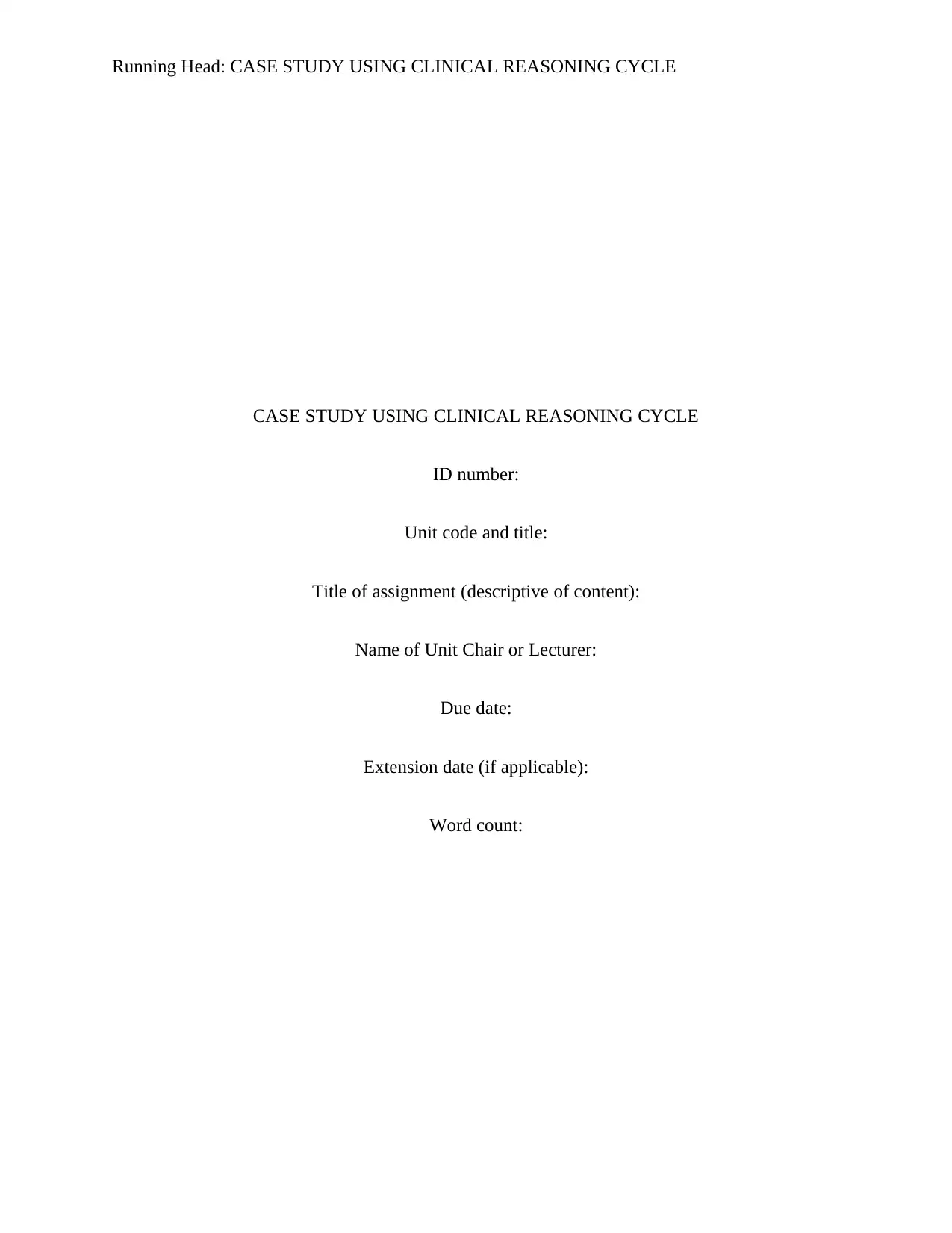
Running Head: CASE STUDY USING CLINICAL REASONING CYCLE
CASE STUDY USING CLINICAL REASONING CYCLE
ID number:
Unit code and title:
Title of assignment (descriptive of content):
Name of Unit Chair or Lecturer:
Due date:
Extension date (if applicable):
Word count:
CASE STUDY USING CLINICAL REASONING CYCLE
ID number:
Unit code and title:
Title of assignment (descriptive of content):
Name of Unit Chair or Lecturer:
Due date:
Extension date (if applicable):
Word count:
Secure Best Marks with AI Grader
Need help grading? Try our AI Grader for instant feedback on your assignments.
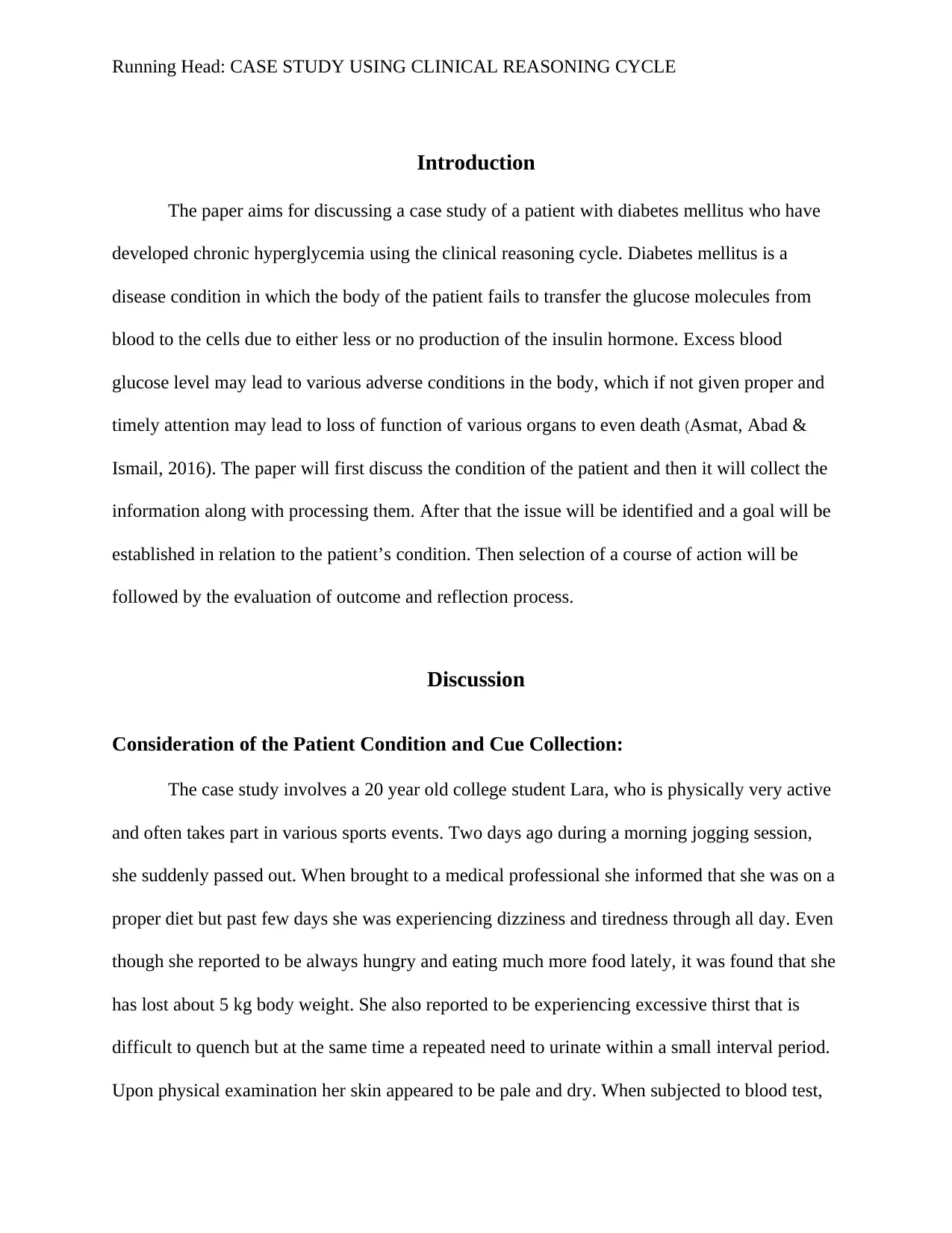
Running Head: CASE STUDY USING CLINICAL REASONING CYCLE
Introduction
The paper aims for discussing a case study of a patient with diabetes mellitus who have
developed chronic hyperglycemia using the clinical reasoning cycle. Diabetes mellitus is a
disease condition in which the body of the patient fails to transfer the glucose molecules from
blood to the cells due to either less or no production of the insulin hormone. Excess blood
glucose level may lead to various adverse conditions in the body, which if not given proper and
timely attention may lead to loss of function of various organs to even death (Asmat, Abad &
Ismail, 2016). The paper will first discuss the condition of the patient and then it will collect the
information along with processing them. After that the issue will be identified and a goal will be
established in relation to the patient’s condition. Then selection of a course of action will be
followed by the evaluation of outcome and reflection process.
Discussion
Consideration of the Patient Condition and Cue Collection:
The case study involves a 20 year old college student Lara, who is physically very active
and often takes part in various sports events. Two days ago during a morning jogging session,
she suddenly passed out. When brought to a medical professional she informed that she was on a
proper diet but past few days she was experiencing dizziness and tiredness through all day. Even
though she reported to be always hungry and eating much more food lately, it was found that she
has lost about 5 kg body weight. She also reported to be experiencing excessive thirst that is
difficult to quench but at the same time a repeated need to urinate within a small interval period.
Upon physical examination her skin appeared to be pale and dry. When subjected to blood test,
Introduction
The paper aims for discussing a case study of a patient with diabetes mellitus who have
developed chronic hyperglycemia using the clinical reasoning cycle. Diabetes mellitus is a
disease condition in which the body of the patient fails to transfer the glucose molecules from
blood to the cells due to either less or no production of the insulin hormone. Excess blood
glucose level may lead to various adverse conditions in the body, which if not given proper and
timely attention may lead to loss of function of various organs to even death (Asmat, Abad &
Ismail, 2016). The paper will first discuss the condition of the patient and then it will collect the
information along with processing them. After that the issue will be identified and a goal will be
established in relation to the patient’s condition. Then selection of a course of action will be
followed by the evaluation of outcome and reflection process.
Discussion
Consideration of the Patient Condition and Cue Collection:
The case study involves a 20 year old college student Lara, who is physically very active
and often takes part in various sports events. Two days ago during a morning jogging session,
she suddenly passed out. When brought to a medical professional she informed that she was on a
proper diet but past few days she was experiencing dizziness and tiredness through all day. Even
though she reported to be always hungry and eating much more food lately, it was found that she
has lost about 5 kg body weight. She also reported to be experiencing excessive thirst that is
difficult to quench but at the same time a repeated need to urinate within a small interval period.
Upon physical examination her skin appeared to be pale and dry. When subjected to blood test,
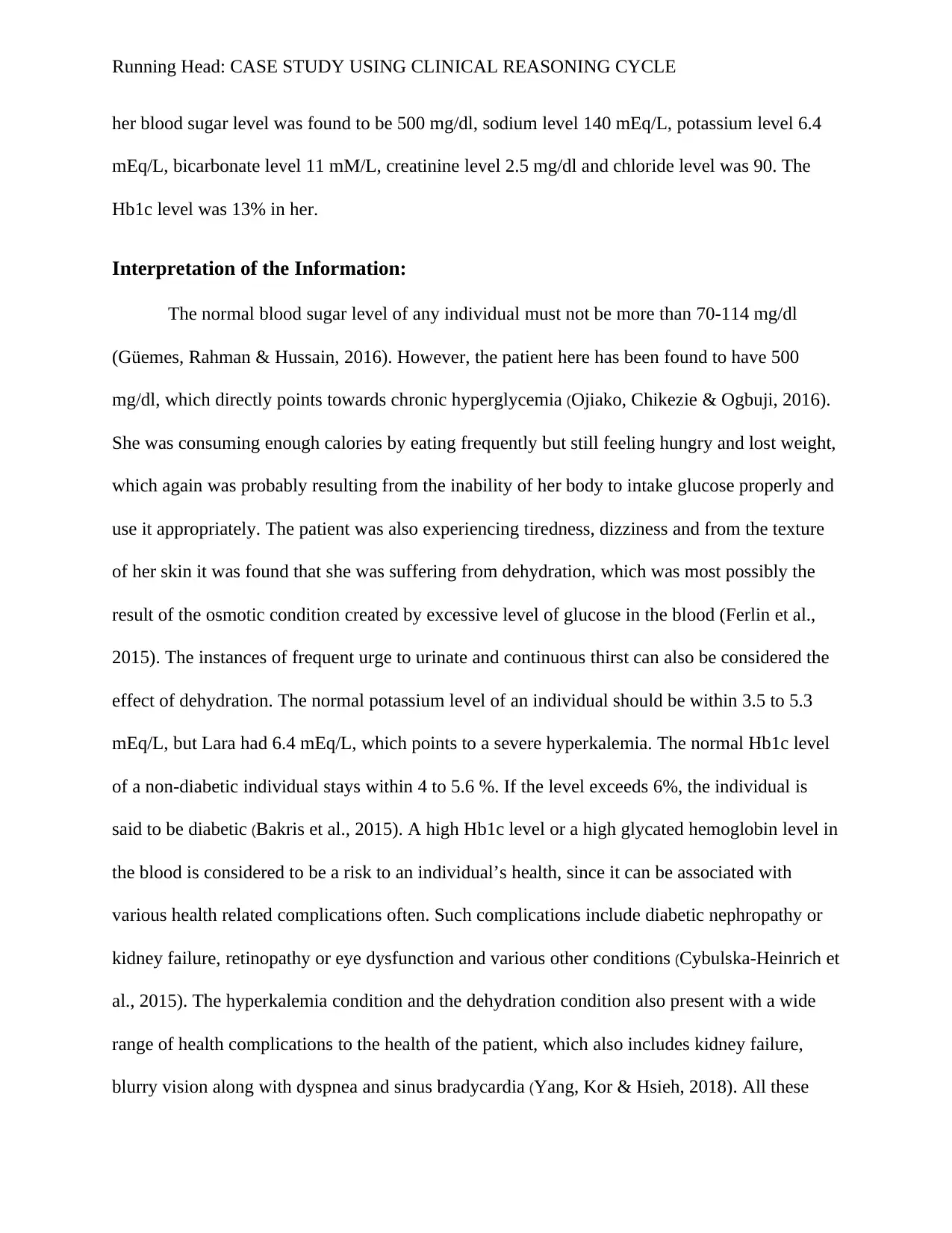
Running Head: CASE STUDY USING CLINICAL REASONING CYCLE
her blood sugar level was found to be 500 mg/dl, sodium level 140 mEq/L, potassium level 6.4
mEq/L, bicarbonate level 11 mM/L, creatinine level 2.5 mg/dl and chloride level was 90. The
Hb1c level was 13% in her.
Interpretation of the Information:
The normal blood sugar level of any individual must not be more than 70-114 mg/dl
(Güemes, Rahman & Hussain, 2016). However, the patient here has been found to have 500
mg/dl, which directly points towards chronic hyperglycemia (Ojiako, Chikezie & Ogbuji, 2016).
She was consuming enough calories by eating frequently but still feeling hungry and lost weight,
which again was probably resulting from the inability of her body to intake glucose properly and
use it appropriately. The patient was also experiencing tiredness, dizziness and from the texture
of her skin it was found that she was suffering from dehydration, which was most possibly the
result of the osmotic condition created by excessive level of glucose in the blood (Ferlin et al.,
2015). The instances of frequent urge to urinate and continuous thirst can also be considered the
effect of dehydration. The normal potassium level of an individual should be within 3.5 to 5.3
mEq/L, but Lara had 6.4 mEq/L, which points to a severe hyperkalemia. The normal Hb1c level
of a non-diabetic individual stays within 4 to 5.6 %. If the level exceeds 6%, the individual is
said to be diabetic (Bakris et al., 2015). A high Hb1c level or a high glycated hemoglobin level in
the blood is considered to be a risk to an individual’s health, since it can be associated with
various health related complications often. Such complications include diabetic nephropathy or
kidney failure, retinopathy or eye dysfunction and various other conditions (Cybulska-Heinrich et
al., 2015). The hyperkalemia condition and the dehydration condition also present with a wide
range of health complications to the health of the patient, which also includes kidney failure,
blurry vision along with dyspnea and sinus bradycardia (Yang, Kor & Hsieh, 2018). All these
her blood sugar level was found to be 500 mg/dl, sodium level 140 mEq/L, potassium level 6.4
mEq/L, bicarbonate level 11 mM/L, creatinine level 2.5 mg/dl and chloride level was 90. The
Hb1c level was 13% in her.
Interpretation of the Information:
The normal blood sugar level of any individual must not be more than 70-114 mg/dl
(Güemes, Rahman & Hussain, 2016). However, the patient here has been found to have 500
mg/dl, which directly points towards chronic hyperglycemia (Ojiako, Chikezie & Ogbuji, 2016).
She was consuming enough calories by eating frequently but still feeling hungry and lost weight,
which again was probably resulting from the inability of her body to intake glucose properly and
use it appropriately. The patient was also experiencing tiredness, dizziness and from the texture
of her skin it was found that she was suffering from dehydration, which was most possibly the
result of the osmotic condition created by excessive level of glucose in the blood (Ferlin et al.,
2015). The instances of frequent urge to urinate and continuous thirst can also be considered the
effect of dehydration. The normal potassium level of an individual should be within 3.5 to 5.3
mEq/L, but Lara had 6.4 mEq/L, which points to a severe hyperkalemia. The normal Hb1c level
of a non-diabetic individual stays within 4 to 5.6 %. If the level exceeds 6%, the individual is
said to be diabetic (Bakris et al., 2015). A high Hb1c level or a high glycated hemoglobin level in
the blood is considered to be a risk to an individual’s health, since it can be associated with
various health related complications often. Such complications include diabetic nephropathy or
kidney failure, retinopathy or eye dysfunction and various other conditions (Cybulska-Heinrich et
al., 2015). The hyperkalemia condition and the dehydration condition also present with a wide
range of health complications to the health of the patient, which also includes kidney failure,
blurry vision along with dyspnea and sinus bradycardia (Yang, Kor & Hsieh, 2018). All these
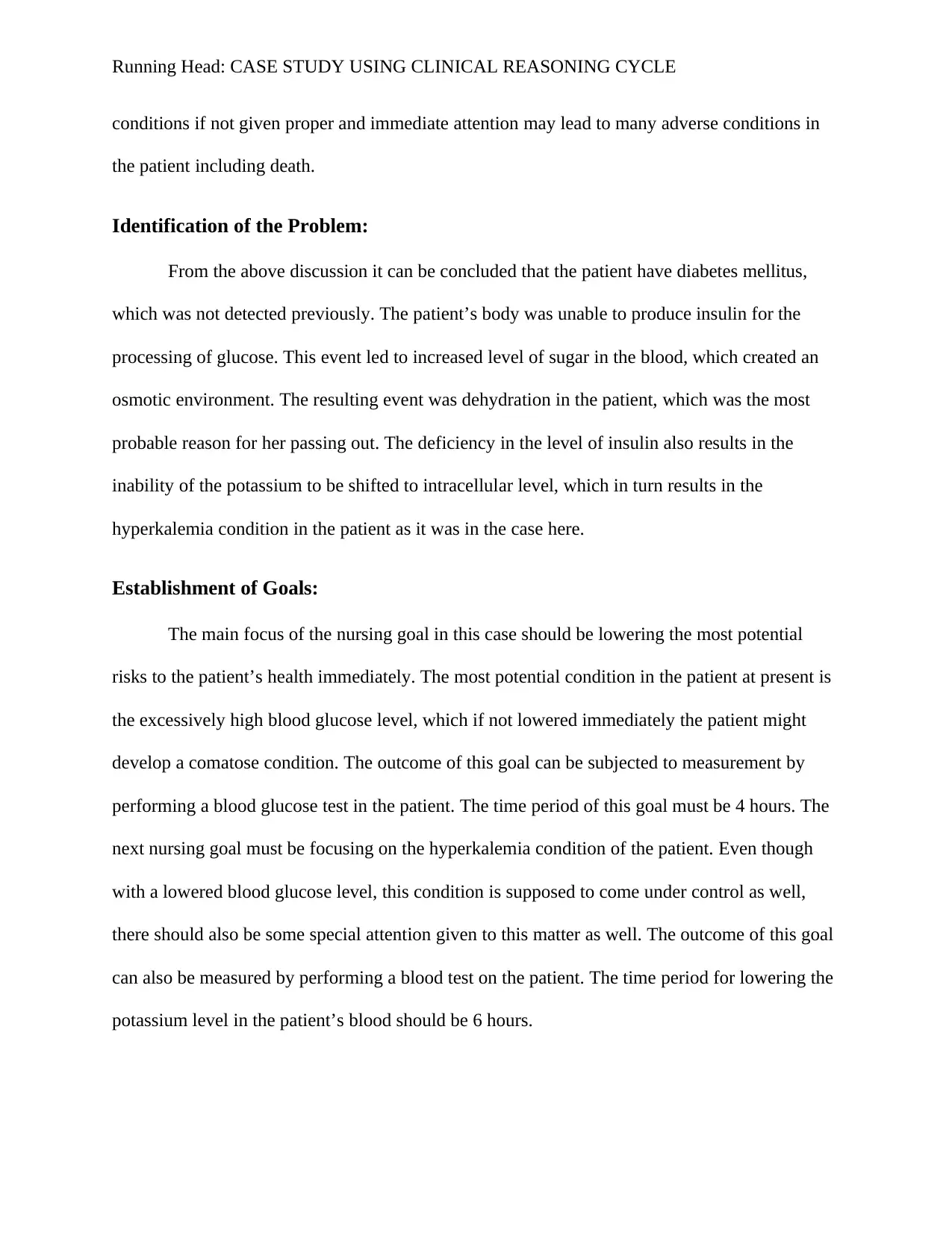
Running Head: CASE STUDY USING CLINICAL REASONING CYCLE
conditions if not given proper and immediate attention may lead to many adverse conditions in
the patient including death.
Identification of the Problem:
From the above discussion it can be concluded that the patient have diabetes mellitus,
which was not detected previously. The patient’s body was unable to produce insulin for the
processing of glucose. This event led to increased level of sugar in the blood, which created an
osmotic environment. The resulting event was dehydration in the patient, which was the most
probable reason for her passing out. The deficiency in the level of insulin also results in the
inability of the potassium to be shifted to intracellular level, which in turn results in the
hyperkalemia condition in the patient as it was in the case here.
Establishment of Goals:
The main focus of the nursing goal in this case should be lowering the most potential
risks to the patient’s health immediately. The most potential condition in the patient at present is
the excessively high blood glucose level, which if not lowered immediately the patient might
develop a comatose condition. The outcome of this goal can be subjected to measurement by
performing a blood glucose test in the patient. The time period of this goal must be 4 hours. The
next nursing goal must be focusing on the hyperkalemia condition of the patient. Even though
with a lowered blood glucose level, this condition is supposed to come under control as well,
there should also be some special attention given to this matter as well. The outcome of this goal
can also be measured by performing a blood test on the patient. The time period for lowering the
potassium level in the patient’s blood should be 6 hours.
conditions if not given proper and immediate attention may lead to many adverse conditions in
the patient including death.
Identification of the Problem:
From the above discussion it can be concluded that the patient have diabetes mellitus,
which was not detected previously. The patient’s body was unable to produce insulin for the
processing of glucose. This event led to increased level of sugar in the blood, which created an
osmotic environment. The resulting event was dehydration in the patient, which was the most
probable reason for her passing out. The deficiency in the level of insulin also results in the
inability of the potassium to be shifted to intracellular level, which in turn results in the
hyperkalemia condition in the patient as it was in the case here.
Establishment of Goals:
The main focus of the nursing goal in this case should be lowering the most potential
risks to the patient’s health immediately. The most potential condition in the patient at present is
the excessively high blood glucose level, which if not lowered immediately the patient might
develop a comatose condition. The outcome of this goal can be subjected to measurement by
performing a blood glucose test in the patient. The time period of this goal must be 4 hours. The
next nursing goal must be focusing on the hyperkalemia condition of the patient. Even though
with a lowered blood glucose level, this condition is supposed to come under control as well,
there should also be some special attention given to this matter as well. The outcome of this goal
can also be measured by performing a blood test on the patient. The time period for lowering the
potassium level in the patient’s blood should be 6 hours.
Secure Best Marks with AI Grader
Need help grading? Try our AI Grader for instant feedback on your assignments.
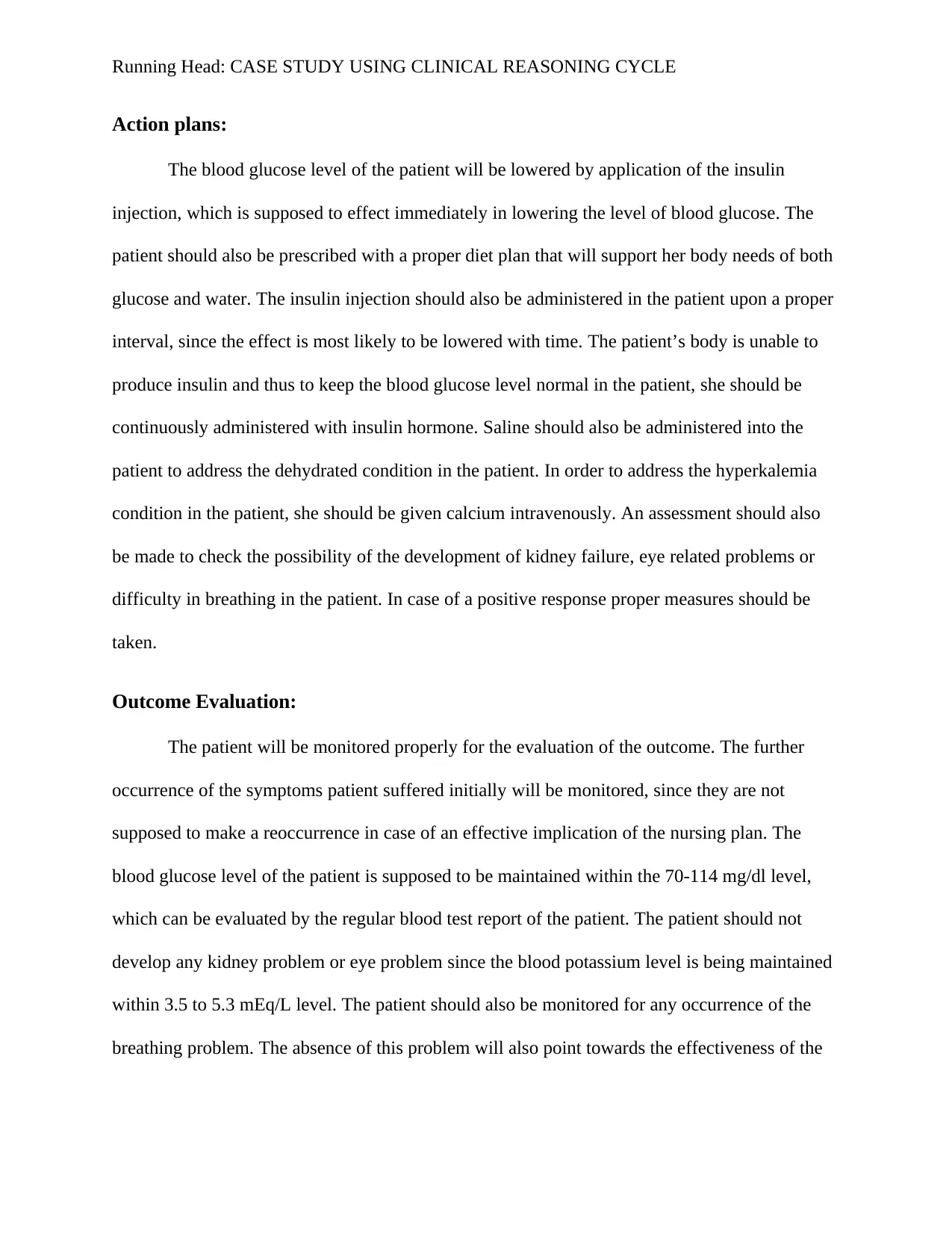
Running Head: CASE STUDY USING CLINICAL REASONING CYCLE
Action plans:
The blood glucose level of the patient will be lowered by application of the insulin
injection, which is supposed to effect immediately in lowering the level of blood glucose. The
patient should also be prescribed with a proper diet plan that will support her body needs of both
glucose and water. The insulin injection should also be administered in the patient upon a proper
interval, since the effect is most likely to be lowered with time. The patient’s body is unable to
produce insulin and thus to keep the blood glucose level normal in the patient, she should be
continuously administered with insulin hormone. Saline should also be administered into the
patient to address the dehydrated condition in the patient. In order to address the hyperkalemia
condition in the patient, she should be given calcium intravenously. An assessment should also
be made to check the possibility of the development of kidney failure, eye related problems or
difficulty in breathing in the patient. In case of a positive response proper measures should be
taken.
Outcome Evaluation:
The patient will be monitored properly for the evaluation of the outcome. The further
occurrence of the symptoms patient suffered initially will be monitored, since they are not
supposed to make a reoccurrence in case of an effective implication of the nursing plan. The
blood glucose level of the patient is supposed to be maintained within the 70-114 mg/dl level,
which can be evaluated by the regular blood test report of the patient. The patient should not
develop any kidney problem or eye problem since the blood potassium level is being maintained
within 3.5 to 5.3 mEq/L level. The patient should also be monitored for any occurrence of the
breathing problem. The absence of this problem will also point towards the effectiveness of the
Action plans:
The blood glucose level of the patient will be lowered by application of the insulin
injection, which is supposed to effect immediately in lowering the level of blood glucose. The
patient should also be prescribed with a proper diet plan that will support her body needs of both
glucose and water. The insulin injection should also be administered in the patient upon a proper
interval, since the effect is most likely to be lowered with time. The patient’s body is unable to
produce insulin and thus to keep the blood glucose level normal in the patient, she should be
continuously administered with insulin hormone. Saline should also be administered into the
patient to address the dehydrated condition in the patient. In order to address the hyperkalemia
condition in the patient, she should be given calcium intravenously. An assessment should also
be made to check the possibility of the development of kidney failure, eye related problems or
difficulty in breathing in the patient. In case of a positive response proper measures should be
taken.
Outcome Evaluation:
The patient will be monitored properly for the evaluation of the outcome. The further
occurrence of the symptoms patient suffered initially will be monitored, since they are not
supposed to make a reoccurrence in case of an effective implication of the nursing plan. The
blood glucose level of the patient is supposed to be maintained within the 70-114 mg/dl level,
which can be evaluated by the regular blood test report of the patient. The patient should not
develop any kidney problem or eye problem since the blood potassium level is being maintained
within 3.5 to 5.3 mEq/L level. The patient should also be monitored for any occurrence of the
breathing problem. The absence of this problem will also point towards the effectiveness of the
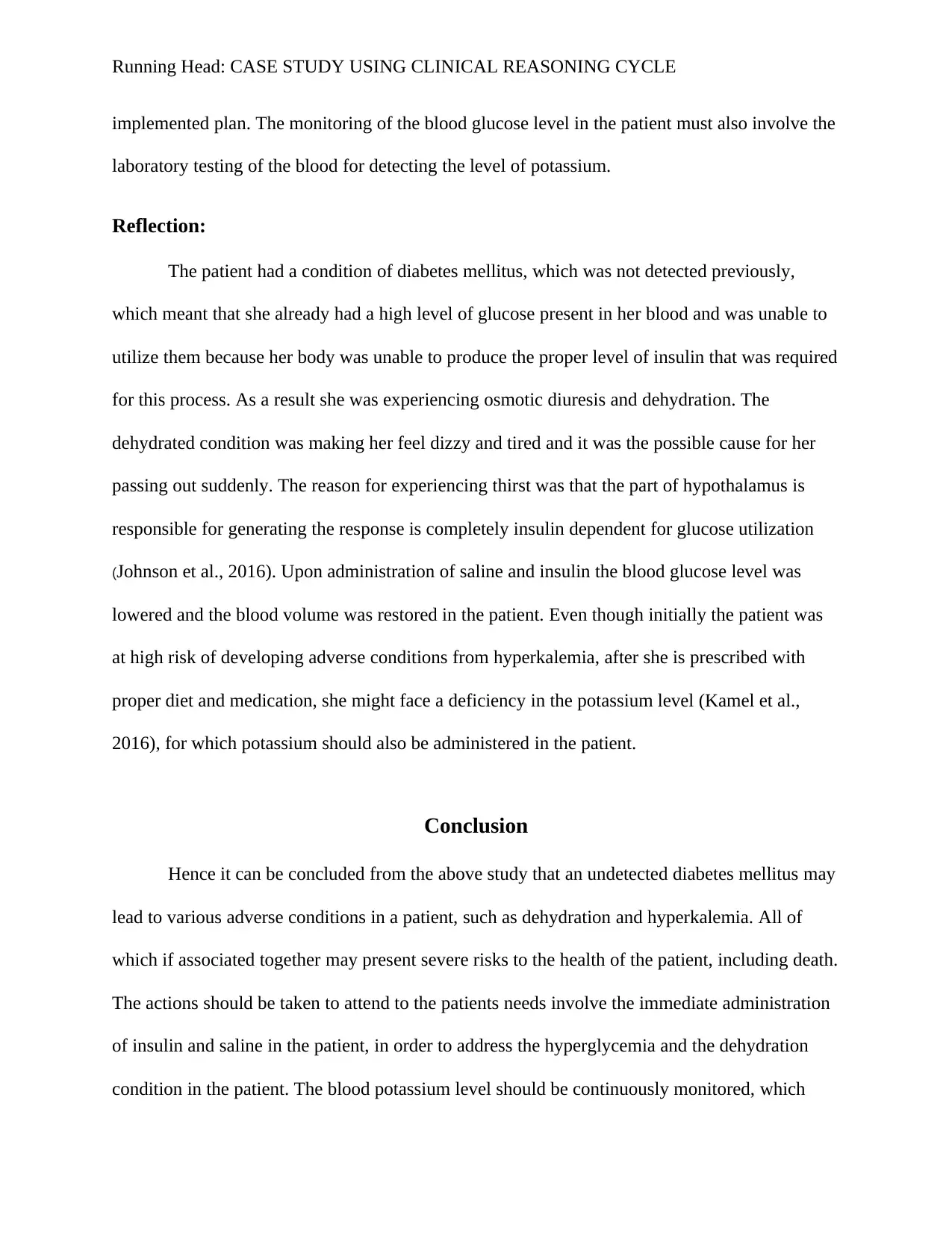
Running Head: CASE STUDY USING CLINICAL REASONING CYCLE
implemented plan. The monitoring of the blood glucose level in the patient must also involve the
laboratory testing of the blood for detecting the level of potassium.
Reflection:
The patient had a condition of diabetes mellitus, which was not detected previously,
which meant that she already had a high level of glucose present in her blood and was unable to
utilize them because her body was unable to produce the proper level of insulin that was required
for this process. As a result she was experiencing osmotic diuresis and dehydration. The
dehydrated condition was making her feel dizzy and tired and it was the possible cause for her
passing out suddenly. The reason for experiencing thirst was that the part of hypothalamus is
responsible for generating the response is completely insulin dependent for glucose utilization
(Johnson et al., 2016). Upon administration of saline and insulin the blood glucose level was
lowered and the blood volume was restored in the patient. Even though initially the patient was
at high risk of developing adverse conditions from hyperkalemia, after she is prescribed with
proper diet and medication, she might face a deficiency in the potassium level (Kamel et al.,
2016), for which potassium should also be administered in the patient.
Conclusion
Hence it can be concluded from the above study that an undetected diabetes mellitus may
lead to various adverse conditions in a patient, such as dehydration and hyperkalemia. All of
which if associated together may present severe risks to the health of the patient, including death.
The actions should be taken to attend to the patients needs involve the immediate administration
of insulin and saline in the patient, in order to address the hyperglycemia and the dehydration
condition in the patient. The blood potassium level should be continuously monitored, which
implemented plan. The monitoring of the blood glucose level in the patient must also involve the
laboratory testing of the blood for detecting the level of potassium.
Reflection:
The patient had a condition of diabetes mellitus, which was not detected previously,
which meant that she already had a high level of glucose present in her blood and was unable to
utilize them because her body was unable to produce the proper level of insulin that was required
for this process. As a result she was experiencing osmotic diuresis and dehydration. The
dehydrated condition was making her feel dizzy and tired and it was the possible cause for her
passing out suddenly. The reason for experiencing thirst was that the part of hypothalamus is
responsible for generating the response is completely insulin dependent for glucose utilization
(Johnson et al., 2016). Upon administration of saline and insulin the blood glucose level was
lowered and the blood volume was restored in the patient. Even though initially the patient was
at high risk of developing adverse conditions from hyperkalemia, after she is prescribed with
proper diet and medication, she might face a deficiency in the potassium level (Kamel et al.,
2016), for which potassium should also be administered in the patient.
Conclusion
Hence it can be concluded from the above study that an undetected diabetes mellitus may
lead to various adverse conditions in a patient, such as dehydration and hyperkalemia. All of
which if associated together may present severe risks to the health of the patient, including death.
The actions should be taken to attend to the patients needs involve the immediate administration
of insulin and saline in the patient, in order to address the hyperglycemia and the dehydration
condition in the patient. The blood potassium level should be continuously monitored, which
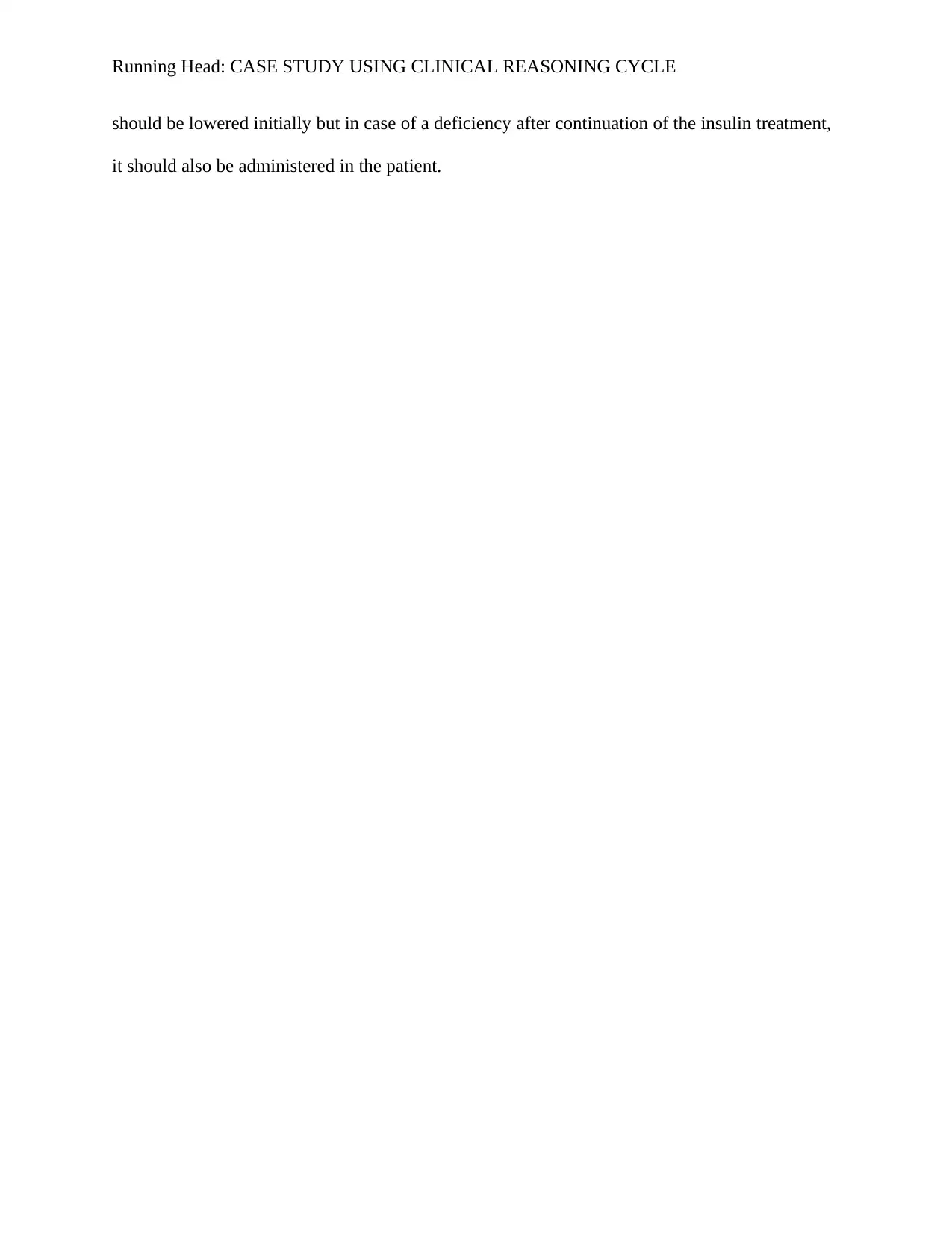
Running Head: CASE STUDY USING CLINICAL REASONING CYCLE
should be lowered initially but in case of a deficiency after continuation of the insulin treatment,
it should also be administered in the patient.
should be lowered initially but in case of a deficiency after continuation of the insulin treatment,
it should also be administered in the patient.
Paraphrase This Document
Need a fresh take? Get an instant paraphrase of this document with our AI Paraphraser
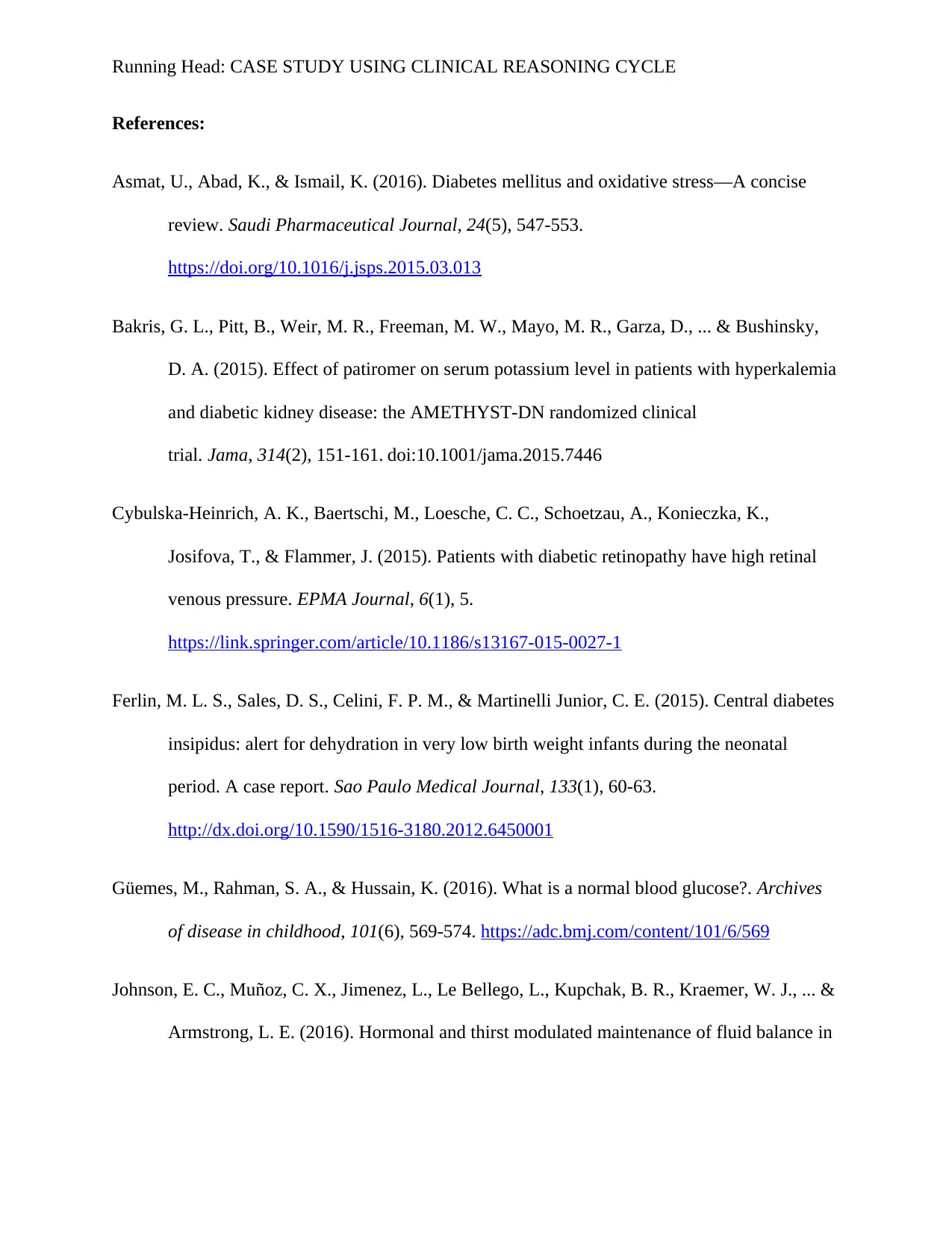
Running Head: CASE STUDY USING CLINICAL REASONING CYCLE
References:
Asmat, U., Abad, K., & Ismail, K. (2016). Diabetes mellitus and oxidative stress—A concise
review. Saudi Pharmaceutical Journal, 24(5), 547-553.
https://doi.org/10.1016/j.jsps.2015.03.013
Bakris, G. L., Pitt, B., Weir, M. R., Freeman, M. W., Mayo, M. R., Garza, D., ... & Bushinsky,
D. A. (2015). Effect of patiromer on serum potassium level in patients with hyperkalemia
and diabetic kidney disease: the AMETHYST-DN randomized clinical
trial. Jama, 314(2), 151-161. doi:10.1001/jama.2015.7446
Cybulska-Heinrich, A. K., Baertschi, M., Loesche, C. C., Schoetzau, A., Konieczka, K.,
Josifova, T., & Flammer, J. (2015). Patients with diabetic retinopathy have high retinal
venous pressure. EPMA Journal, 6(1), 5.
https://link.springer.com/article/10.1186/s13167-015-0027-1
Ferlin, M. L. S., Sales, D. S., Celini, F. P. M., & Martinelli Junior, C. E. (2015). Central diabetes
insipidus: alert for dehydration in very low birth weight infants during the neonatal
period. A case report. Sao Paulo Medical Journal, 133(1), 60-63.
http://dx.doi.org/10.1590/1516-3180.2012.6450001
Güemes, M., Rahman, S. A., & Hussain, K. (2016). What is a normal blood glucose?. Archives
of disease in childhood, 101(6), 569-574. https://adc.bmj.com/content/101/6/569
Johnson, E. C., Muñoz, C. X., Jimenez, L., Le Bellego, L., Kupchak, B. R., Kraemer, W. J., ... &
Armstrong, L. E. (2016). Hormonal and thirst modulated maintenance of fluid balance in
References:
Asmat, U., Abad, K., & Ismail, K. (2016). Diabetes mellitus and oxidative stress—A concise
review. Saudi Pharmaceutical Journal, 24(5), 547-553.
https://doi.org/10.1016/j.jsps.2015.03.013
Bakris, G. L., Pitt, B., Weir, M. R., Freeman, M. W., Mayo, M. R., Garza, D., ... & Bushinsky,
D. A. (2015). Effect of patiromer on serum potassium level in patients with hyperkalemia
and diabetic kidney disease: the AMETHYST-DN randomized clinical
trial. Jama, 314(2), 151-161. doi:10.1001/jama.2015.7446
Cybulska-Heinrich, A. K., Baertschi, M., Loesche, C. C., Schoetzau, A., Konieczka, K.,
Josifova, T., & Flammer, J. (2015). Patients with diabetic retinopathy have high retinal
venous pressure. EPMA Journal, 6(1), 5.
https://link.springer.com/article/10.1186/s13167-015-0027-1
Ferlin, M. L. S., Sales, D. S., Celini, F. P. M., & Martinelli Junior, C. E. (2015). Central diabetes
insipidus: alert for dehydration in very low birth weight infants during the neonatal
period. A case report. Sao Paulo Medical Journal, 133(1), 60-63.
http://dx.doi.org/10.1590/1516-3180.2012.6450001
Güemes, M., Rahman, S. A., & Hussain, K. (2016). What is a normal blood glucose?. Archives
of disease in childhood, 101(6), 569-574. https://adc.bmj.com/content/101/6/569
Johnson, E. C., Muñoz, C. X., Jimenez, L., Le Bellego, L., Kupchak, B. R., Kraemer, W. J., ... &
Armstrong, L. E. (2016). Hormonal and thirst modulated maintenance of fluid balance in
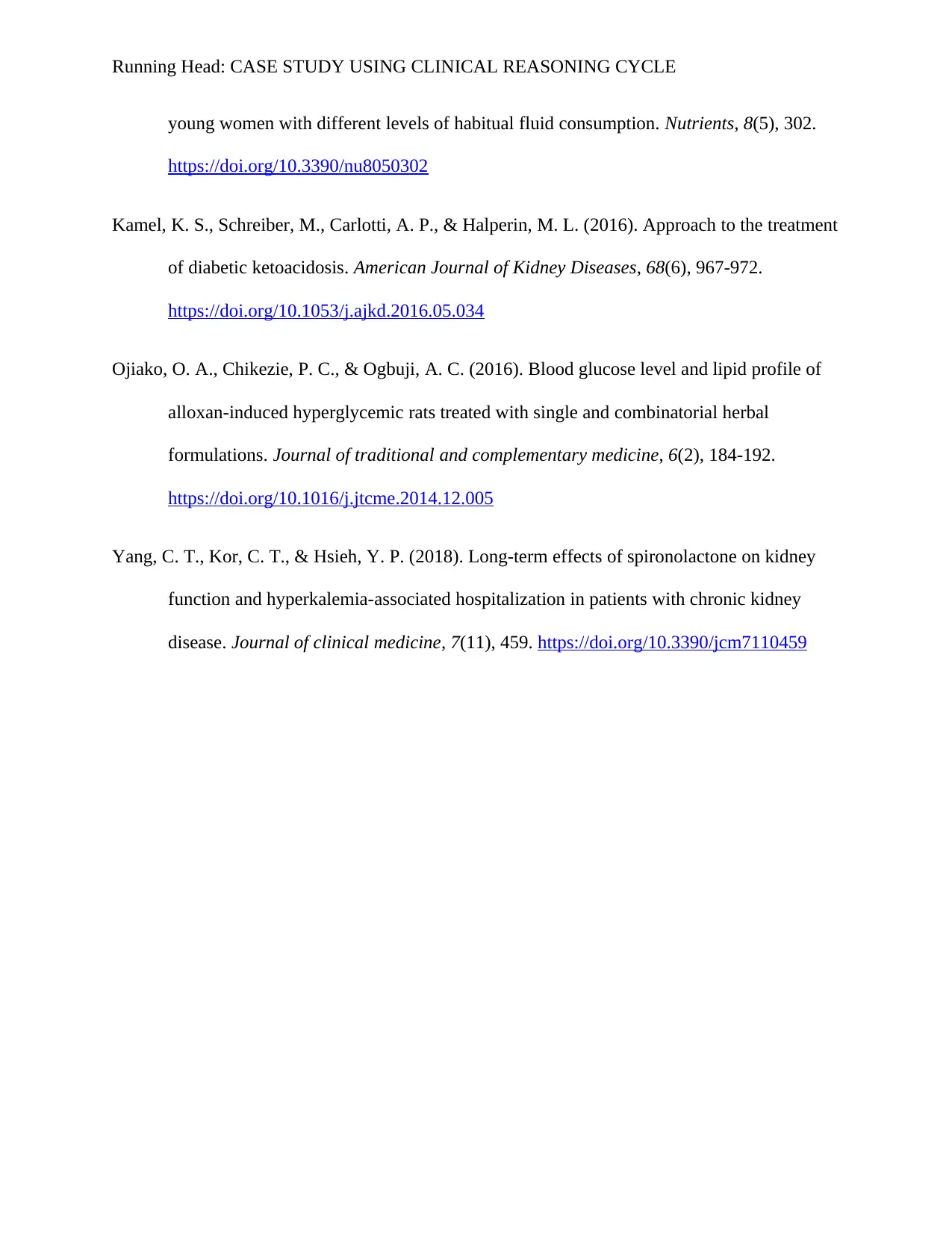
Running Head: CASE STUDY USING CLINICAL REASONING CYCLE
young women with different levels of habitual fluid consumption. Nutrients, 8(5), 302.
https://doi.org/10.3390/nu8050302
Kamel, K. S., Schreiber, M., Carlotti, A. P., & Halperin, M. L. (2016). Approach to the treatment
of diabetic ketoacidosis. American Journal of Kidney Diseases, 68(6), 967-972.
https://doi.org/10.1053/j.ajkd.2016.05.034
Ojiako, O. A., Chikezie, P. C., & Ogbuji, A. C. (2016). Blood glucose level and lipid profile of
alloxan-induced hyperglycemic rats treated with single and combinatorial herbal
formulations. Journal of traditional and complementary medicine, 6(2), 184-192.
https://doi.org/10.1016/j.jtcme.2014.12.005
Yang, C. T., Kor, C. T., & Hsieh, Y. P. (2018). Long-term effects of spironolactone on kidney
function and hyperkalemia-associated hospitalization in patients with chronic kidney
disease. Journal of clinical medicine, 7(11), 459. https://doi.org/10.3390/jcm7110459
young women with different levels of habitual fluid consumption. Nutrients, 8(5), 302.
https://doi.org/10.3390/nu8050302
Kamel, K. S., Schreiber, M., Carlotti, A. P., & Halperin, M. L. (2016). Approach to the treatment
of diabetic ketoacidosis. American Journal of Kidney Diseases, 68(6), 967-972.
https://doi.org/10.1053/j.ajkd.2016.05.034
Ojiako, O. A., Chikezie, P. C., & Ogbuji, A. C. (2016). Blood glucose level and lipid profile of
alloxan-induced hyperglycemic rats treated with single and combinatorial herbal
formulations. Journal of traditional and complementary medicine, 6(2), 184-192.
https://doi.org/10.1016/j.jtcme.2014.12.005
Yang, C. T., Kor, C. T., & Hsieh, Y. P. (2018). Long-term effects of spironolactone on kidney
function and hyperkalemia-associated hospitalization in patients with chronic kidney
disease. Journal of clinical medicine, 7(11), 459. https://doi.org/10.3390/jcm7110459
1 out of 9
Related Documents
Your All-in-One AI-Powered Toolkit for Academic Success.
+13062052269
info@desklib.com
Available 24*7 on WhatsApp / Email
![[object Object]](/_next/static/media/star-bottom.7253800d.svg)
Unlock your academic potential
© 2024 | Zucol Services PVT LTD | All rights reserved.




